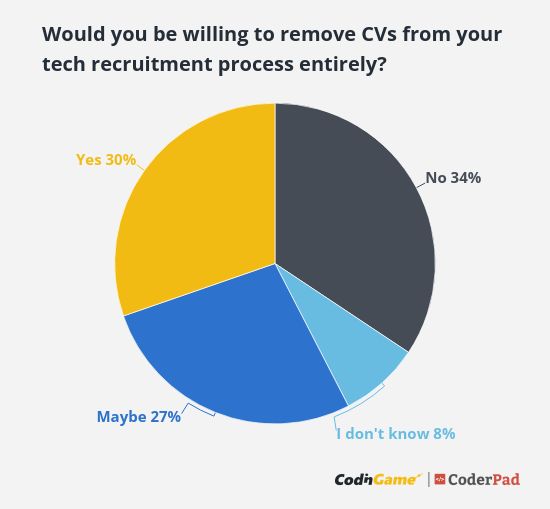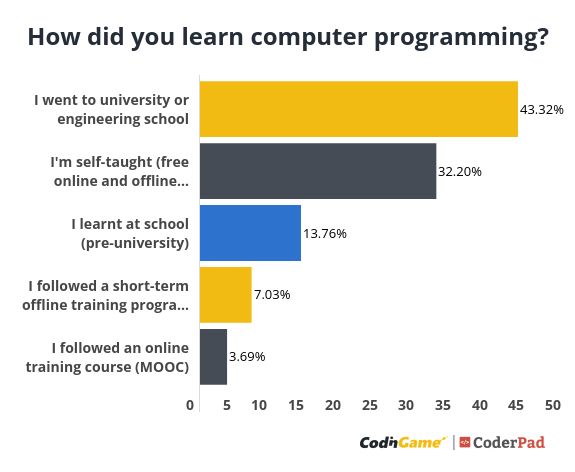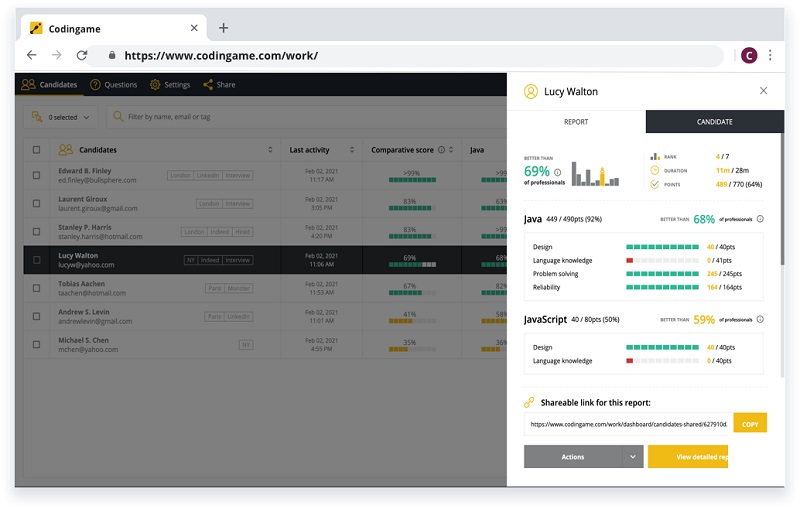57% of tech recruiters are open to ditching the resume. This result was revealed during our recent survey of 14,000 tech recruiters and developers.

But expressing an openness to doing something is one thing. Actually taking action to accomplish it is another. Many recruiters recognize the limitations of the CV but also can’t envisage another way of recruiting. What are the practical steps to recruit without a resume? And why is it worth making this change?
Here we’ll look at why a reliance on resumes limits your success in tech recruiting and how to practically organize your recruitment process to find the best candidates without ever looking at a resume.
Can you trust a resume?
The resume has several major weaknesses. Sometimes the information is not accurate. This can involve some simple exaggeration, such as evaluating one’s coding skills far more generously than an objective observer would. Sometimes people are dishonest. In the UK, 10% of people admitted to having lied on their resumes and the number one thing they fibbed about was education or qualifications.
Sometimes people undersell themselves. Developers are often pragmatic and might write a bare bones resume that doesn’t fully highlight their true capabilities. This puts the recruiter at risk of believing the overly optimistic but less talented developer over the humbler one.
The resume introduces bias
Bias also creeps in when reading resumes. Many studies have shown differing results based on the ethnicity of the name on the resume, for example. There is also a positive bias which can creep in. The similarity bias means that recruiters might subconsciously evaluate more positively a candidate who is similar to them. This could be as simple as sharing the same hometown and occurs without realizing. You wouldn’t purposely discriminate but without realizing you could be easier on one candidate than another, without even realizing it.
This bias is especially problematic in the tech world. 65% of tech recruiters in our survey reported that bias is an issue in tech recruiting. The resume, with a non standard format, allows many details which are not strictly relevant to the position, to potentially subconsciously sway the recruiter in one direction or another.
What about the self-taught coders?
A resume generally has an education section and an experience section. While other parts might vary, these two are generally consistent. Some candidates will shine in these areas, with recognisable names in each section, casting a glow of positive association on the candidate.
But as we know from looking at the tech world, not every brilliant programmer gets a degree. Some people come to programming later and choose a boot camp or YouTube videos over spending four years in a university. Others start at university but become disillusioned when the degree is more theoretical than practical. Some drop out and go on to form billion dollar companies.

In our survey we found that 1 out of 3 developer participants taught themselves to code, using free online and offline resources, such as tutorials, books and YouTube. Another 10% learned through a short-term offline training program (such as a boot camp) or took an online training course.
With the evolution of languages and frameworks, there is a need to stay up-to-date. Developers might work in a position where they use only one language every day and knowledge in others they learned in the classroom can fade (how much of your college Spanish do you remember?).
The coders learning in their free time, making projects, and devoting time to their skills could very well have more of the up-to-date knowledge you need than the person with the famous names on the resume. But how could this passionate autodidact also shine on the traditional resume?
When the resume makes candidates invisible
Frédéric Desmoulins, CEO and founder of CodinGame, was once in this position. A talented self-taught programmer, the skills but his resume did not capture the interest of recruiters. Finally, he left Montpellier for Oxford where he studied for a Master’s degree in computer science. It wasn’t the degree that gave him his skills but that additional line on his resume appeared to be the passport. He was no longer invisible to recruiters, in fact he was recruited as a software engineer by Capgemini.

This experience led to the founding of CodinGame. CodinGame aims to help people shine for their skills, to empower recruiters to find the best candidates, regardless of their resumes.
More and more recruiters are realizing the limitations or only hiring those who have studied computer engineering at university. 39% of recruiters in our 2022 survey said they regularly hire developers from non-academic backgrounds. This is a significant increase from last year, when only 23% said the same. This increasing willingness to look beyond the degree is a win for everyone.
It’s not always easy to take this step, if you haven’t designed your recruiting process to be inclusive. 28% of tech recruiters also mentioned that “Identifying potential even if candidates don’t have the perfect matching skill set” as a main challenge when recruiting developers, making it the biggest challenge after “Finding qualified candidates”.
So what are the concrete steps you can take to make the shift from resume-based filtering to skills-based hiring?
What is skills-based hiring and how is it the solution?
A developer will pass many working hours coding. In this way, it is easy to define which skills are necessary for the position. If you are looking to hire someone who can be operational quickly, without needing extra training or mentoring, it is useful to ensure they are good at these specific skills.
The obvious solution is to assess these skills, rather than making guesses based on work experience or the name of a university. Focus on the candidate’s current skill set, rather than looking at the past, such as work experience or education. You take the subjectivity out of the matter when you assess these skills with an objective measure and can fairly compare.
There are multiple advantages to this approach:
- You widen your talent pool. The market is tight and the demand for developers exceeds the supply. By focusing on skills rather than eliminating candidates early based on less relevant factors, you ensure you don’t miss hidden gems and remove the guesswork.
- You speed up time-to-hire. It’s much quicker to filter candidates on an objective ranking of skills to decide who to interview than guessing over CVs and adding touch points to the recruitment process.
- You can save time and money. Assuming a candidate has the skills based on a degree can be risky. If you find out they don’t have the skills you expected, there can be training costs or even the cost of rehiring for the position.
- You can boost retention. If you give people a chance who might have been ignored by other more closed-minded recruiters, they are more likely to stay longer in the position. Whereas if you only focus on the people with flashy resumes who are routinely headhunted, there is a greater risk that they might flit to another company and you’ll be back recruiting again.
- You reduce bias to improve diversity. 66% of recruiters agree that bias is an issue in tech. We all want to get better at this. 42% said that they use skill-based technical assessment tools to improve diversity. It allows you to make objective decisions and avoid the traps that the human brain can set for us which can discriminate against some candidates.
How to efficiently integrate skills-based hiring into your recruitment process
With the right tool, it’s quick and easy to set up a technical assessment. With CodinGame Assessment, you can set up a test in just a few clicks and without any specialist knowledge. Of course, if you have the tech skills, you can choose specific questions or add custom questions but the beauty of the product is that even if you don’t, you can use the test builder and know that the test will contain questions based on the latest updates which have been verified by thousands of other candidates.
There is no burden to the tech team as grading is instantaneous and for someone evaluating without the same language skills, there is the possibility of simply relying on the detailed report. In addition to breaking down skills, it also gives you a clear idea of how this candidate would compare to others taking the test. While a score based just on the number of correct questions can be difficult to interpret, a direct comparison based on the performance of thousands of other candidates removes all doubt. This is a benefit over creating your own internal test. It can be difficult to judge the difficulty of questions you create and therefore to judge the performance. You risk creating an unfair test when you do it internally.

Why test early?
To ensure you don’t lose any talented candidates due to human bias and erroneous filtering, it’s best to test early in the process. If you combine CodinGame Assessment with an Applicant Tracking System (ATS), you can automate the process so that all candidates are invited to take a screening test. This removes the filtering step. Not all candidates may choose to take the test, just as not all candidates may agree to a phone screening interview. Instead of potentially chasing down candidates who wouldn’t be a good fit, however, you receive a handy list ranking them by their skills and can then choose the best to contact for an interview.
A soft skills interview with HR and a technical interview with a tech lead complete the process. Gone are the steps of reading resumes and cover letters, trying to judge degrees and identify which resumes are exaggerated and which are underselling the person. You also have the peace of mind of knowing the process was completely objective and free of bias.
How to present initial screening to candidates?
Some recruiters worry that if they try to test candidates too early in the process, they might offend them or scare them off. This doesn’t have to be the case. It is important to approach this correctly so that candidates understand the reasoning, feel their time is respected, and that you do value them.
Follow these steps to integrate early testing while providing an excellent candidate experience.
- In your job ad, explain that testing is the first step in your process. This sets expectations and eliminates the risk that candidates feel that they are being targeted for a test. Be up front about the time commitment so candidates can plan appropriately.
- Highlight how testing helps you hire fairly and improves diversity. Let candidates know that you are committed to hiring based on skills and not judging candidates on irrelevant details. That you are open to hiring a range of people, even if they don’t have the degree from the big university or are starting out in their coding careers.
- Keep the assessment as short as you can. Be respectful of candidates’ time by choosing an appropriate length for the test. Only include the skills which are really necessary to the post. A test that can be completed in one hour or less is ideal and if you find that you can design one for your needs that is even shorter, that’s even better.
- Focus only on relevant skills. Developers joke about the job ads which have a laundry list of nice-to-have skills which are completely unnecessary for the actual post. Show you are more realistic and focus only on the skills which will actually make a difference day-to-day. Developers appreciate this pragmatic approach.
- Send developers their results. Doing a test to never find out how you performed can be frustrating. If you use a tool, such as CodinGame Assessment, which automatically sends a brief report to candidates, you provide a better experience. Candidates who underperform will understand why they’re not selected for the next step. Receiving results also provides an additional incentive to complete the test.
By taking care of these points, you can create a positive experience for candidates while creating a quick, efficient and fair recruitment process. Everyone wins.
Takeaways
- Look past the resume. It’s an imperfect tool which introduces bias and leads to short-sighted recruiting choices
- Adopt a policy of fairness and equity in your hiring and communicate this with candidates
- Test early in the process to be as fair as possible and save time
- Make assessments as relevant as possible by only focusing on the skills the developer will use day to day
- Be mindful of the length so as to respect candidates’ time

